International Business Report: US-China Trade War and Australia
VerifiedAdded on 2023/04/20
|9
|2161
|476
Report
AI Summary
This report provides an analysis of the US-China trade war, focusing on the key findings of the KPMG report, which assessed the economic implications of the trade disagreements between the two countries. The report summarizes the KPMG report's key findings, including the negative impacts on both the US and China, as well as the global economy, under different scenarios of escalation and contagion. It also examines the subsequent developments in the US-China trade disagreements, such as the imposition of tariffs and retaliatory measures. Furthermore, the report discusses these developments in the context of three scenarios modeled by KPMG: limited escalation with no contagion, full escalation with no contagion, and full escalation with full contagion. The analysis highlights the potential consequences for Australia and other countries under each scenario, emphasizing the adverse effects of an all-out trade war and the importance of avoiding protectionist measures.
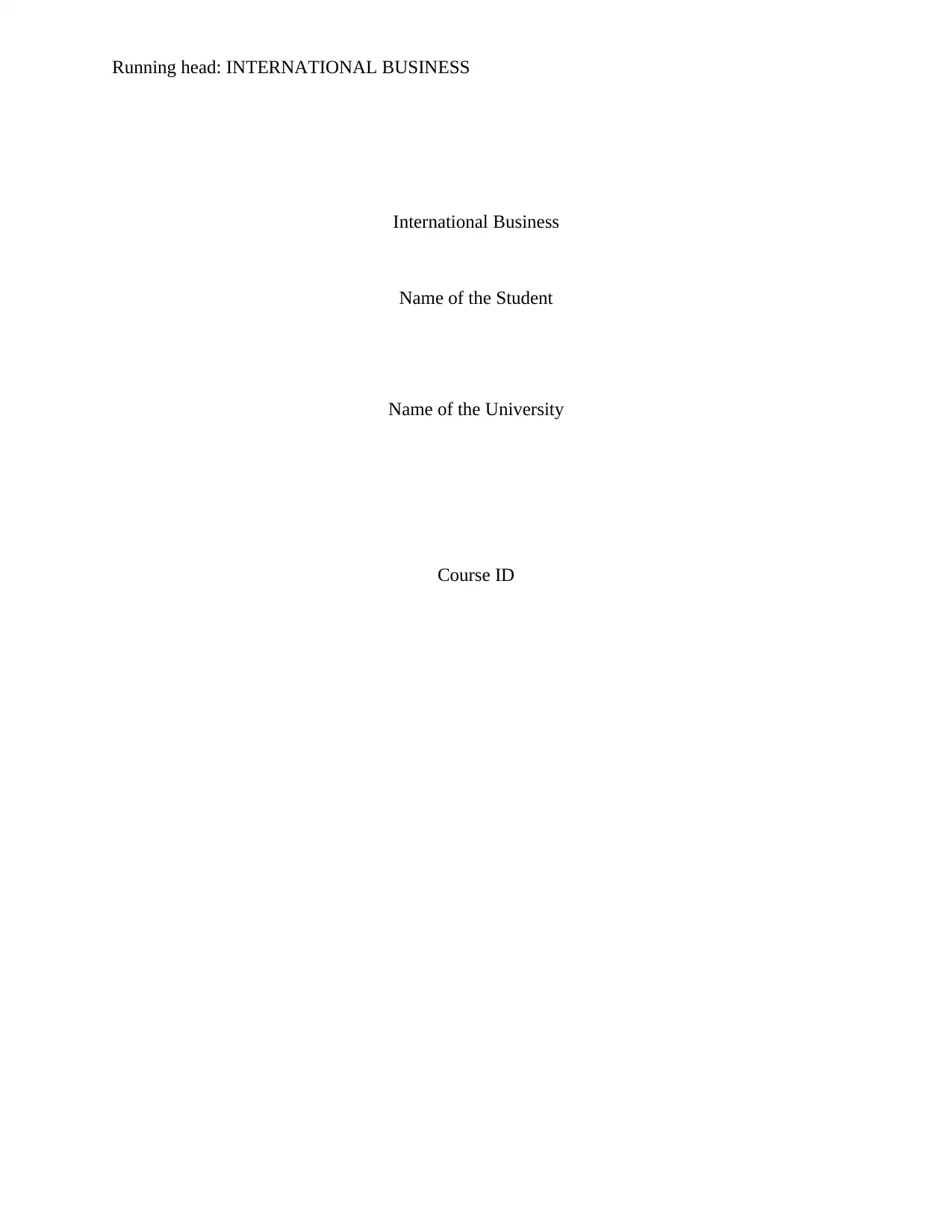
Running head: INTERNATIONAL BUSINESS
International Business
Name of the Student
Name of the University
Course ID
International Business
Name of the Student
Name of the University
Course ID
Paraphrase This Document
Need a fresh take? Get an instant paraphrase of this document with our AI Paraphraser
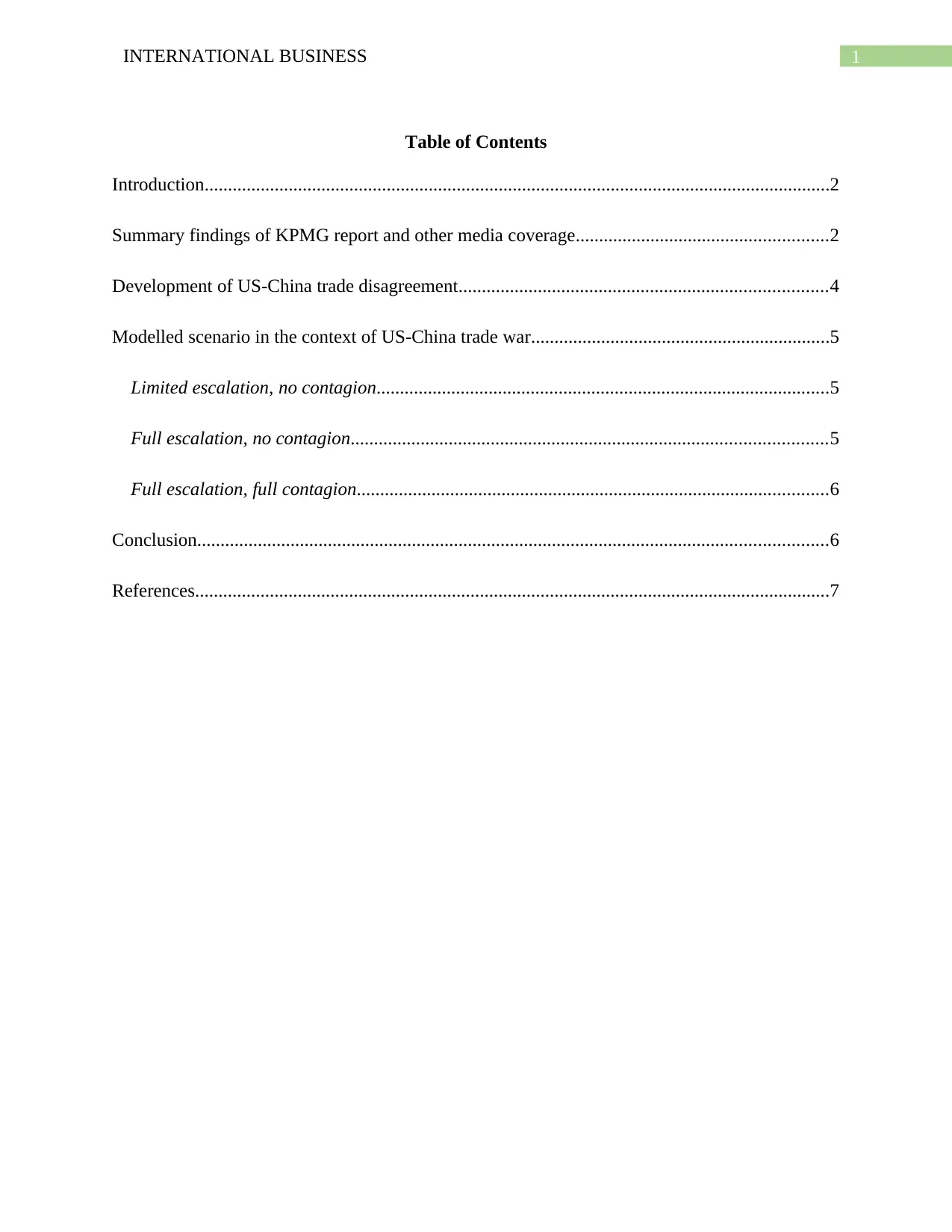
1INTERNATIONAL BUSINESS
Table of Contents
Introduction......................................................................................................................................2
Summary findings of KPMG report and other media coverage......................................................2
Development of US-China trade disagreement...............................................................................4
Modelled scenario in the context of US-China trade war................................................................5
Limited escalation, no contagion.................................................................................................5
Full escalation, no contagion......................................................................................................5
Full escalation, full contagion.....................................................................................................6
Conclusion.......................................................................................................................................6
References........................................................................................................................................7
Table of Contents
Introduction......................................................................................................................................2
Summary findings of KPMG report and other media coverage......................................................2
Development of US-China trade disagreement...............................................................................4
Modelled scenario in the context of US-China trade war................................................................5
Limited escalation, no contagion.................................................................................................5
Full escalation, no contagion......................................................................................................5
Full escalation, full contagion.....................................................................................................6
Conclusion.......................................................................................................................................6
References........................................................................................................................................7
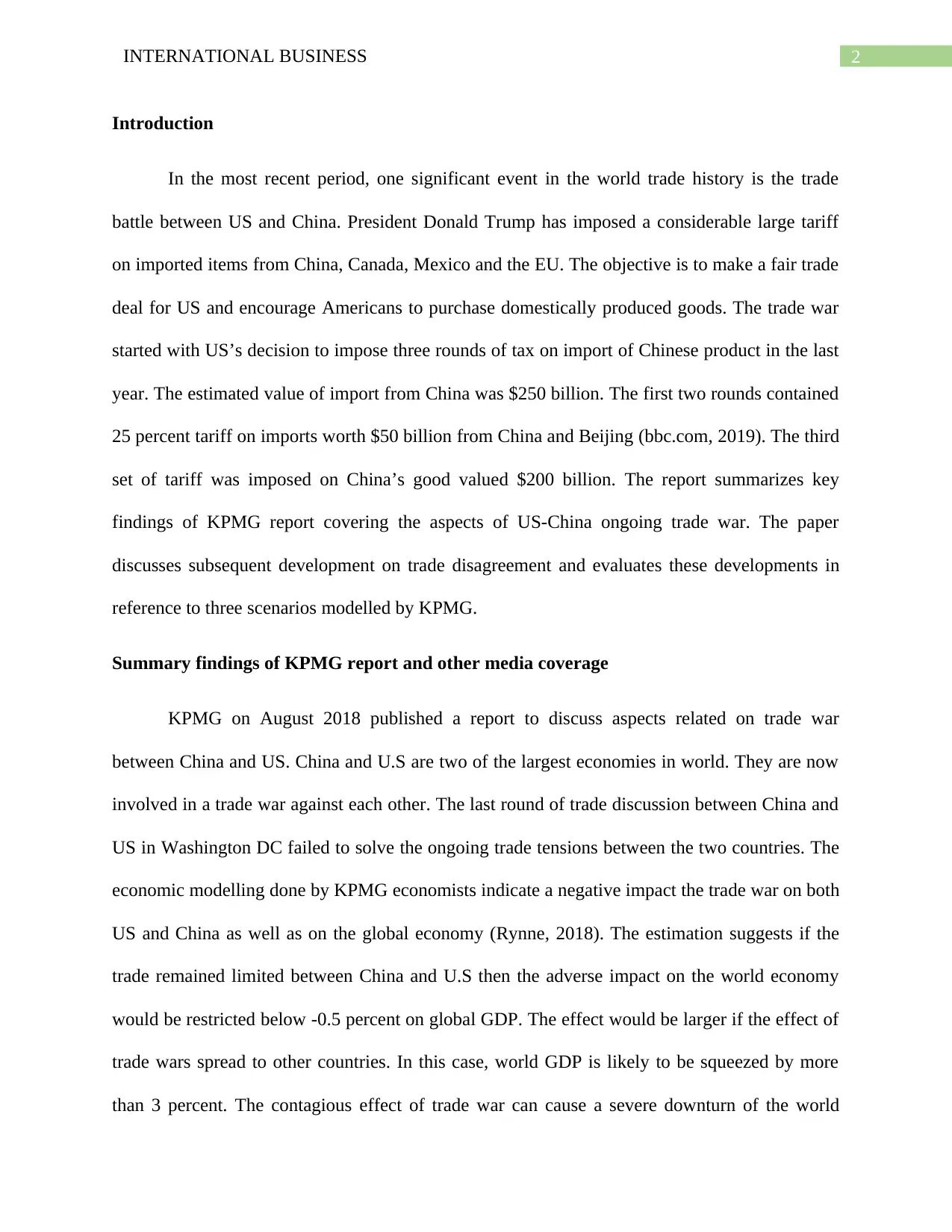
2INTERNATIONAL BUSINESS
Introduction
In the most recent period, one significant event in the world trade history is the trade
battle between US and China. President Donald Trump has imposed a considerable large tariff
on imported items from China, Canada, Mexico and the EU. The objective is to make a fair trade
deal for US and encourage Americans to purchase domestically produced goods. The trade war
started with US’s decision to impose three rounds of tax on import of Chinese product in the last
year. The estimated value of import from China was $250 billion. The first two rounds contained
25 percent tariff on imports worth $50 billion from China and Beijing (bbc.com, 2019). The third
set of tariff was imposed on China’s good valued $200 billion. The report summarizes key
findings of KPMG report covering the aspects of US-China ongoing trade war. The paper
discusses subsequent development on trade disagreement and evaluates these developments in
reference to three scenarios modelled by KPMG.
Summary findings of KPMG report and other media coverage
KPMG on August 2018 published a report to discuss aspects related on trade war
between China and US. China and U.S are two of the largest economies in world. They are now
involved in a trade war against each other. The last round of trade discussion between China and
US in Washington DC failed to solve the ongoing trade tensions between the two countries. The
economic modelling done by KPMG economists indicate a negative impact the trade war on both
US and China as well as on the global economy (Rynne, 2018). The estimation suggests if the
trade remained limited between China and U.S then the adverse impact on the world economy
would be restricted below -0.5 percent on global GDP. The effect would be larger if the effect of
trade wars spread to other countries. In this case, world GDP is likely to be squeezed by more
than 3 percent. The contagious effect of trade war can cause a severe downturn of the world
Introduction
In the most recent period, one significant event in the world trade history is the trade
battle between US and China. President Donald Trump has imposed a considerable large tariff
on imported items from China, Canada, Mexico and the EU. The objective is to make a fair trade
deal for US and encourage Americans to purchase domestically produced goods. The trade war
started with US’s decision to impose three rounds of tax on import of Chinese product in the last
year. The estimated value of import from China was $250 billion. The first two rounds contained
25 percent tariff on imports worth $50 billion from China and Beijing (bbc.com, 2019). The third
set of tariff was imposed on China’s good valued $200 billion. The report summarizes key
findings of KPMG report covering the aspects of US-China ongoing trade war. The paper
discusses subsequent development on trade disagreement and evaluates these developments in
reference to three scenarios modelled by KPMG.
Summary findings of KPMG report and other media coverage
KPMG on August 2018 published a report to discuss aspects related on trade war
between China and US. China and U.S are two of the largest economies in world. They are now
involved in a trade war against each other. The last round of trade discussion between China and
US in Washington DC failed to solve the ongoing trade tensions between the two countries. The
economic modelling done by KPMG economists indicate a negative impact the trade war on both
US and China as well as on the global economy (Rynne, 2018). The estimation suggests if the
trade remained limited between China and U.S then the adverse impact on the world economy
would be restricted below -0.5 percent on global GDP. The effect would be larger if the effect of
trade wars spread to other countries. In this case, world GDP is likely to be squeezed by more
than 3 percent. The contagious effect of trade war can cause a severe downturn of the world
⊘ This is a preview!⊘
Do you want full access?
Subscribe today to unlock all pages.

Trusted by 1+ million students worldwide
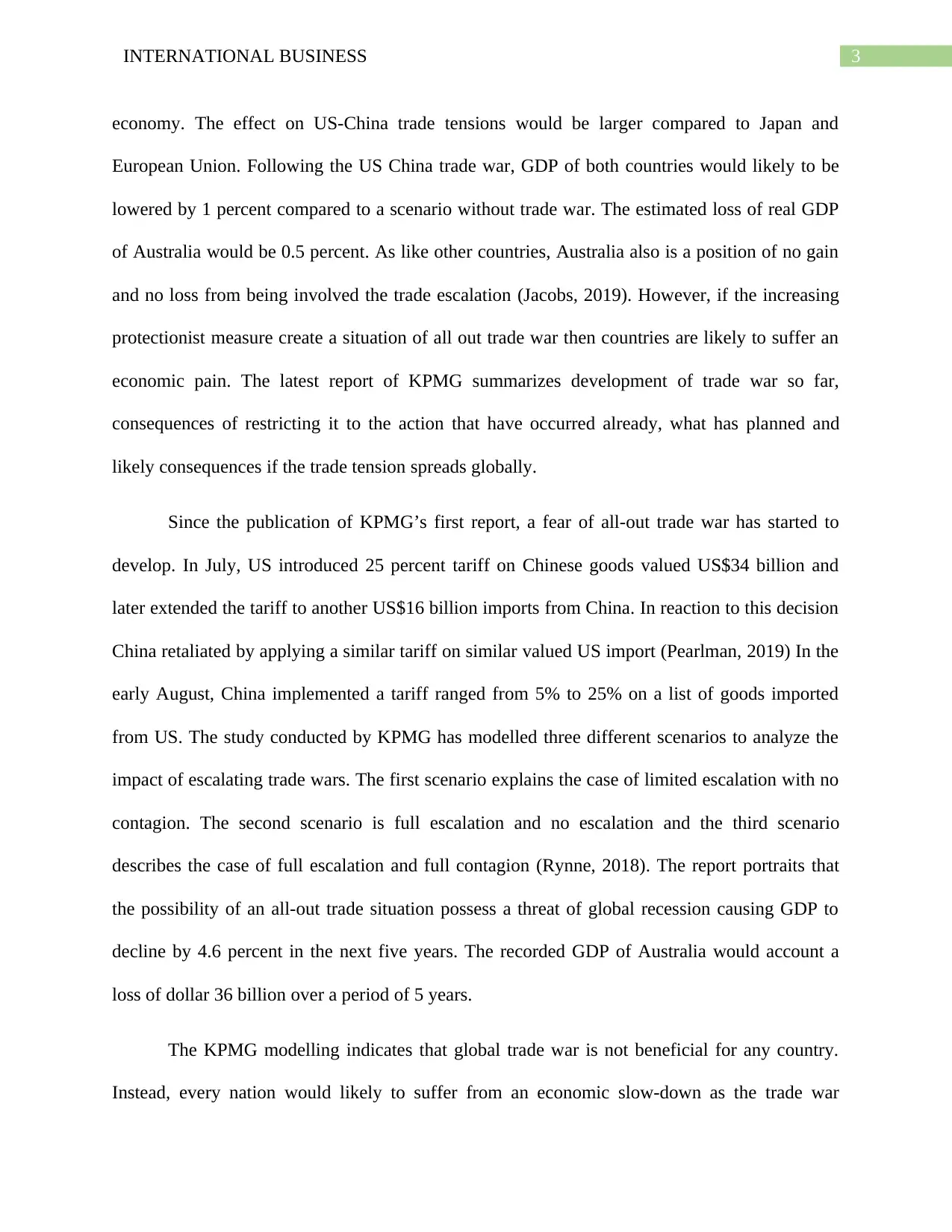
3INTERNATIONAL BUSINESS
economy. The effect on US-China trade tensions would be larger compared to Japan and
European Union. Following the US China trade war, GDP of both countries would likely to be
lowered by 1 percent compared to a scenario without trade war. The estimated loss of real GDP
of Australia would be 0.5 percent. As like other countries, Australia also is a position of no gain
and no loss from being involved the trade escalation (Jacobs, 2019). However, if the increasing
protectionist measure create a situation of all out trade war then countries are likely to suffer an
economic pain. The latest report of KPMG summarizes development of trade war so far,
consequences of restricting it to the action that have occurred already, what has planned and
likely consequences if the trade tension spreads globally.
Since the publication of KPMG’s first report, a fear of all-out trade war has started to
develop. In July, US introduced 25 percent tariff on Chinese goods valued US$34 billion and
later extended the tariff to another US$16 billion imports from China. In reaction to this decision
China retaliated by applying a similar tariff on similar valued US import (Pearlman, 2019) In the
early August, China implemented a tariff ranged from 5% to 25% on a list of goods imported
from US. The study conducted by KPMG has modelled three different scenarios to analyze the
impact of escalating trade wars. The first scenario explains the case of limited escalation with no
contagion. The second scenario is full escalation and no escalation and the third scenario
describes the case of full escalation and full contagion (Rynne, 2018). The report portraits that
the possibility of an all-out trade situation possess a threat of global recession causing GDP to
decline by 4.6 percent in the next five years. The recorded GDP of Australia would account a
loss of dollar 36 billion over a period of 5 years.
The KPMG modelling indicates that global trade war is not beneficial for any country.
Instead, every nation would likely to suffer from an economic slow-down as the trade war
economy. The effect on US-China trade tensions would be larger compared to Japan and
European Union. Following the US China trade war, GDP of both countries would likely to be
lowered by 1 percent compared to a scenario without trade war. The estimated loss of real GDP
of Australia would be 0.5 percent. As like other countries, Australia also is a position of no gain
and no loss from being involved the trade escalation (Jacobs, 2019). However, if the increasing
protectionist measure create a situation of all out trade war then countries are likely to suffer an
economic pain. The latest report of KPMG summarizes development of trade war so far,
consequences of restricting it to the action that have occurred already, what has planned and
likely consequences if the trade tension spreads globally.
Since the publication of KPMG’s first report, a fear of all-out trade war has started to
develop. In July, US introduced 25 percent tariff on Chinese goods valued US$34 billion and
later extended the tariff to another US$16 billion imports from China. In reaction to this decision
China retaliated by applying a similar tariff on similar valued US import (Pearlman, 2019) In the
early August, China implemented a tariff ranged from 5% to 25% on a list of goods imported
from US. The study conducted by KPMG has modelled three different scenarios to analyze the
impact of escalating trade wars. The first scenario explains the case of limited escalation with no
contagion. The second scenario is full escalation and no escalation and the third scenario
describes the case of full escalation and full contagion (Rynne, 2018). The report portraits that
the possibility of an all-out trade situation possess a threat of global recession causing GDP to
decline by 4.6 percent in the next five years. The recorded GDP of Australia would account a
loss of dollar 36 billion over a period of 5 years.
The KPMG modelling indicates that global trade war is not beneficial for any country.
Instead, every nation would likely to suffer from an economic slow-down as the trade war
Paraphrase This Document
Need a fresh take? Get an instant paraphrase of this document with our AI Paraphraser
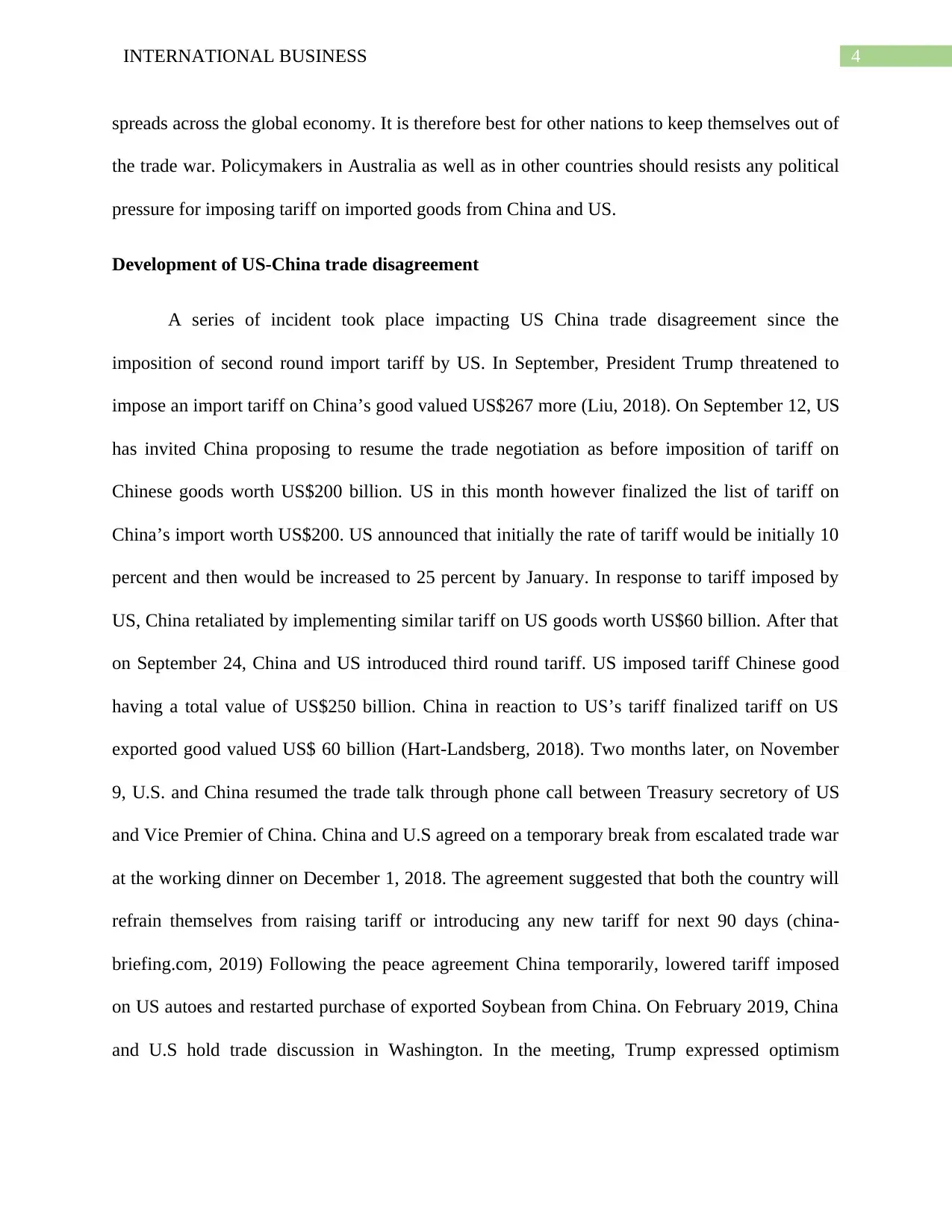
4INTERNATIONAL BUSINESS
spreads across the global economy. It is therefore best for other nations to keep themselves out of
the trade war. Policymakers in Australia as well as in other countries should resists any political
pressure for imposing tariff on imported goods from China and US.
Development of US-China trade disagreement
A series of incident took place impacting US China trade disagreement since the
imposition of second round import tariff by US. In September, President Trump threatened to
impose an import tariff on China’s good valued US$267 more (Liu, 2018). On September 12, US
has invited China proposing to resume the trade negotiation as before imposition of tariff on
Chinese goods worth US$200 billion. US in this month however finalized the list of tariff on
China’s import worth US$200. US announced that initially the rate of tariff would be initially 10
percent and then would be increased to 25 percent by January. In response to tariff imposed by
US, China retaliated by implementing similar tariff on US goods worth US$60 billion. After that
on September 24, China and US introduced third round tariff. US imposed tariff Chinese good
having a total value of US$250 billion. China in reaction to US’s tariff finalized tariff on US
exported good valued US$ 60 billion (Hart-Landsberg, 2018). Two months later, on November
9, U.S. and China resumed the trade talk through phone call between Treasury secretory of US
and Vice Premier of China. China and U.S agreed on a temporary break from escalated trade war
at the working dinner on December 1, 2018. The agreement suggested that both the country will
refrain themselves from raising tariff or introducing any new tariff for next 90 days (china-
briefing.com, 2019) Following the peace agreement China temporarily, lowered tariff imposed
on US autoes and restarted purchase of exported Soybean from China. On February 2019, China
and U.S hold trade discussion in Washington. In the meeting, Trump expressed optimism
spreads across the global economy. It is therefore best for other nations to keep themselves out of
the trade war. Policymakers in Australia as well as in other countries should resists any political
pressure for imposing tariff on imported goods from China and US.
Development of US-China trade disagreement
A series of incident took place impacting US China trade disagreement since the
imposition of second round import tariff by US. In September, President Trump threatened to
impose an import tariff on China’s good valued US$267 more (Liu, 2018). On September 12, US
has invited China proposing to resume the trade negotiation as before imposition of tariff on
Chinese goods worth US$200 billion. US in this month however finalized the list of tariff on
China’s import worth US$200. US announced that initially the rate of tariff would be initially 10
percent and then would be increased to 25 percent by January. In response to tariff imposed by
US, China retaliated by implementing similar tariff on US goods worth US$60 billion. After that
on September 24, China and US introduced third round tariff. US imposed tariff Chinese good
having a total value of US$250 billion. China in reaction to US’s tariff finalized tariff on US
exported good valued US$ 60 billion (Hart-Landsberg, 2018). Two months later, on November
9, U.S. and China resumed the trade talk through phone call between Treasury secretory of US
and Vice Premier of China. China and U.S agreed on a temporary break from escalated trade war
at the working dinner on December 1, 2018. The agreement suggested that both the country will
refrain themselves from raising tariff or introducing any new tariff for next 90 days (china-
briefing.com, 2019) Following the peace agreement China temporarily, lowered tariff imposed
on US autoes and restarted purchase of exported Soybean from China. On February 2019, China
and U.S hold trade discussion in Washington. In the meeting, Trump expressed optimism
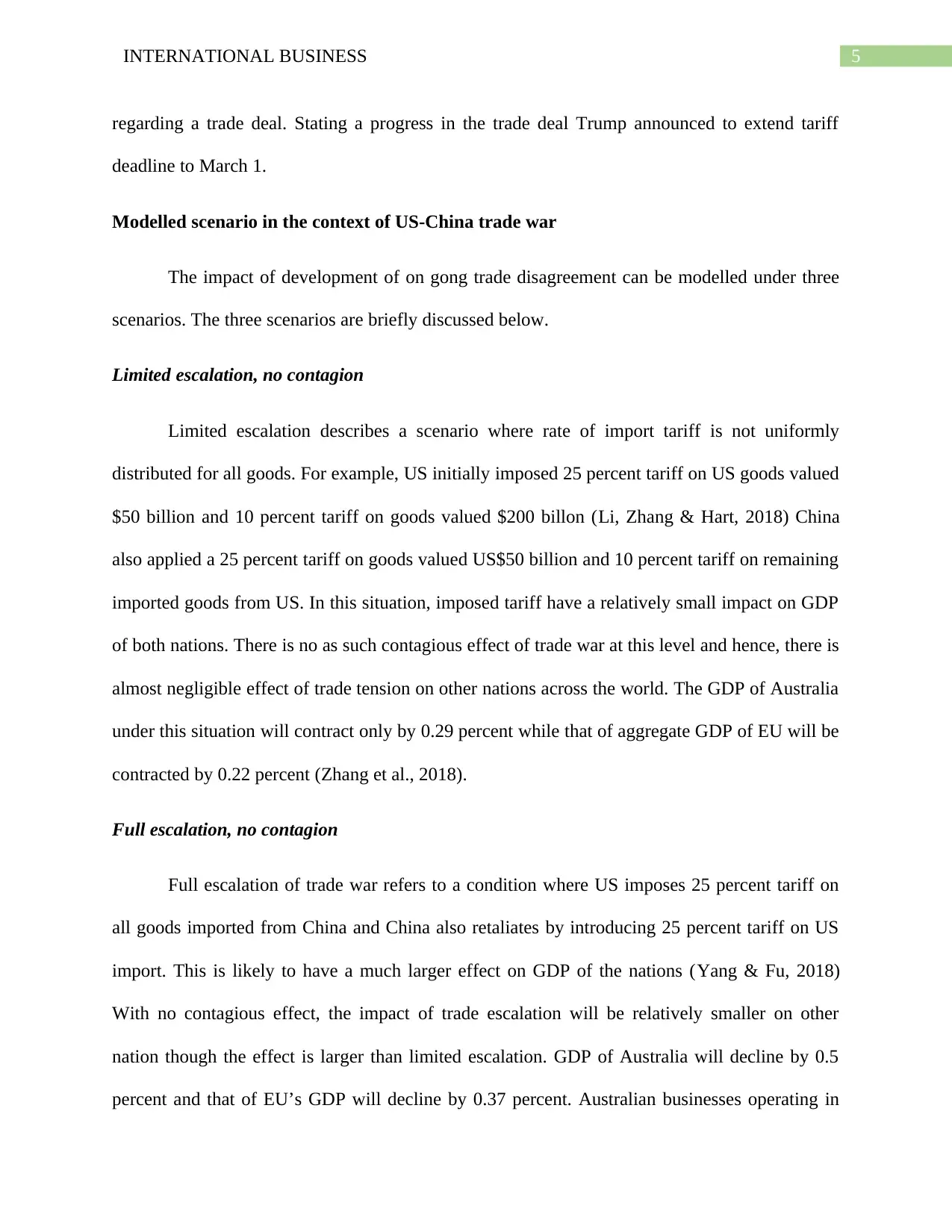
5INTERNATIONAL BUSINESS
regarding a trade deal. Stating a progress in the trade deal Trump announced to extend tariff
deadline to March 1.
Modelled scenario in the context of US-China trade war
The impact of development of on gong trade disagreement can be modelled under three
scenarios. The three scenarios are briefly discussed below.
Limited escalation, no contagion
Limited escalation describes a scenario where rate of import tariff is not uniformly
distributed for all goods. For example, US initially imposed 25 percent tariff on US goods valued
$50 billion and 10 percent tariff on goods valued $200 billon (Li, Zhang & Hart, 2018) China
also applied a 25 percent tariff on goods valued US$50 billion and 10 percent tariff on remaining
imported goods from US. In this situation, imposed tariff have a relatively small impact on GDP
of both nations. There is no as such contagious effect of trade war at this level and hence, there is
almost negligible effect of trade tension on other nations across the world. The GDP of Australia
under this situation will contract only by 0.29 percent while that of aggregate GDP of EU will be
contracted by 0.22 percent (Zhang et al., 2018).
Full escalation, no contagion
Full escalation of trade war refers to a condition where US imposes 25 percent tariff on
all goods imported from China and China also retaliates by introducing 25 percent tariff on US
import. This is likely to have a much larger effect on GDP of the nations (Yang & Fu, 2018)
With no contagious effect, the impact of trade escalation will be relatively smaller on other
nation though the effect is larger than limited escalation. GDP of Australia will decline by 0.5
percent and that of EU’s GDP will decline by 0.37 percent. Australian businesses operating in
regarding a trade deal. Stating a progress in the trade deal Trump announced to extend tariff
deadline to March 1.
Modelled scenario in the context of US-China trade war
The impact of development of on gong trade disagreement can be modelled under three
scenarios. The three scenarios are briefly discussed below.
Limited escalation, no contagion
Limited escalation describes a scenario where rate of import tariff is not uniformly
distributed for all goods. For example, US initially imposed 25 percent tariff on US goods valued
$50 billion and 10 percent tariff on goods valued $200 billon (Li, Zhang & Hart, 2018) China
also applied a 25 percent tariff on goods valued US$50 billion and 10 percent tariff on remaining
imported goods from US. In this situation, imposed tariff have a relatively small impact on GDP
of both nations. There is no as such contagious effect of trade war at this level and hence, there is
almost negligible effect of trade tension on other nations across the world. The GDP of Australia
under this situation will contract only by 0.29 percent while that of aggregate GDP of EU will be
contracted by 0.22 percent (Zhang et al., 2018).
Full escalation, no contagion
Full escalation of trade war refers to a condition where US imposes 25 percent tariff on
all goods imported from China and China also retaliates by introducing 25 percent tariff on US
import. This is likely to have a much larger effect on GDP of the nations (Yang & Fu, 2018)
With no contagious effect, the impact of trade escalation will be relatively smaller on other
nation though the effect is larger than limited escalation. GDP of Australia will decline by 0.5
percent and that of EU’s GDP will decline by 0.37 percent. Australian businesses operating in
⊘ This is a preview!⊘
Do you want full access?
Subscribe today to unlock all pages.

Trusted by 1+ million students worldwide
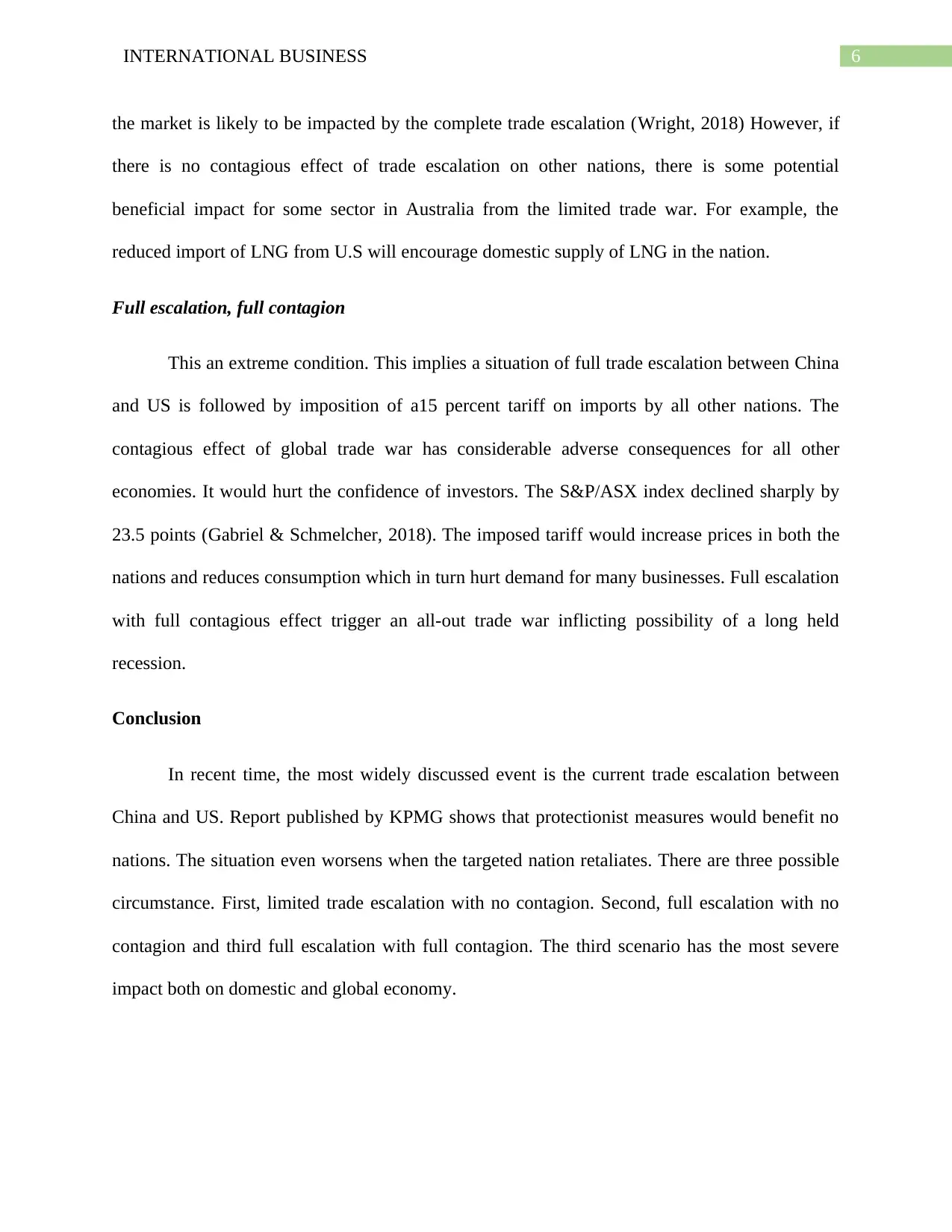
6INTERNATIONAL BUSINESS
the market is likely to be impacted by the complete trade escalation (Wright, 2018) However, if
there is no contagious effect of trade escalation on other nations, there is some potential
beneficial impact for some sector in Australia from the limited trade war. For example, the
reduced import of LNG from U.S will encourage domestic supply of LNG in the nation.
Full escalation, full contagion
This an extreme condition. This implies a situation of full trade escalation between China
and US is followed by imposition of a15 percent tariff on imports by all other nations. The
contagious effect of global trade war has considerable adverse consequences for all other
economies. It would hurt the confidence of investors. The S&P/ASX index declined sharply by
23.5 points (Gabriel & Schmelcher, 2018). The imposed tariff would increase prices in both the
nations and reduces consumption which in turn hurt demand for many businesses. Full escalation
with full contagious effect trigger an all-out trade war inflicting possibility of a long held
recession.
Conclusion
In recent time, the most widely discussed event is the current trade escalation between
China and US. Report published by KPMG shows that protectionist measures would benefit no
nations. The situation even worsens when the targeted nation retaliates. There are three possible
circumstance. First, limited trade escalation with no contagion. Second, full escalation with no
contagion and third full escalation with full contagion. The third scenario has the most severe
impact both on domestic and global economy.
the market is likely to be impacted by the complete trade escalation (Wright, 2018) However, if
there is no contagious effect of trade escalation on other nations, there is some potential
beneficial impact for some sector in Australia from the limited trade war. For example, the
reduced import of LNG from U.S will encourage domestic supply of LNG in the nation.
Full escalation, full contagion
This an extreme condition. This implies a situation of full trade escalation between China
and US is followed by imposition of a15 percent tariff on imports by all other nations. The
contagious effect of global trade war has considerable adverse consequences for all other
economies. It would hurt the confidence of investors. The S&P/ASX index declined sharply by
23.5 points (Gabriel & Schmelcher, 2018). The imposed tariff would increase prices in both the
nations and reduces consumption which in turn hurt demand for many businesses. Full escalation
with full contagious effect trigger an all-out trade war inflicting possibility of a long held
recession.
Conclusion
In recent time, the most widely discussed event is the current trade escalation between
China and US. Report published by KPMG shows that protectionist measures would benefit no
nations. The situation even worsens when the targeted nation retaliates. There are three possible
circumstance. First, limited trade escalation with no contagion. Second, full escalation with no
contagion and third full escalation with full contagion. The third scenario has the most severe
impact both on domestic and global economy.
Paraphrase This Document
Need a fresh take? Get an instant paraphrase of this document with our AI Paraphraser
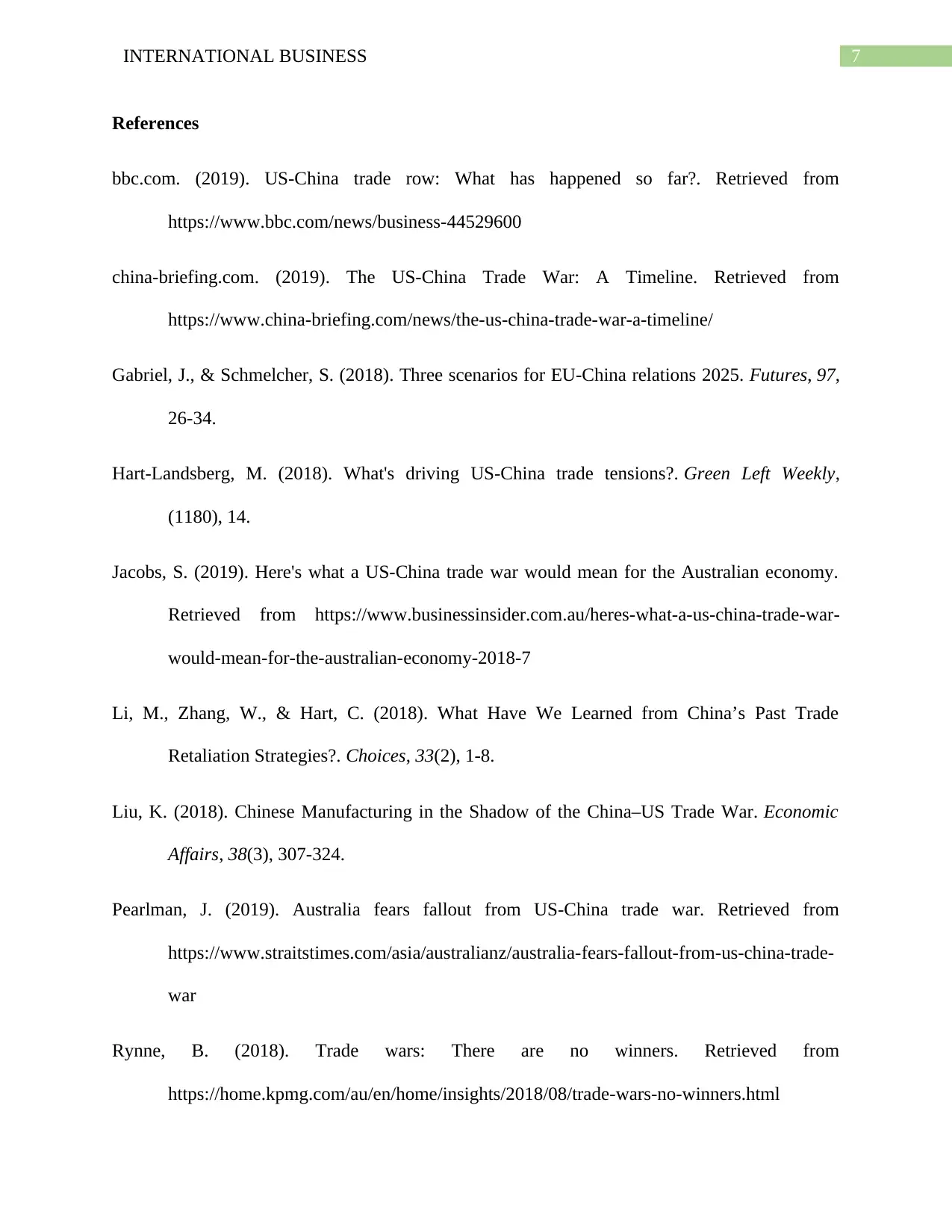
7INTERNATIONAL BUSINESS
References
bbc.com. (2019). US-China trade row: What has happened so far?. Retrieved from
https://www.bbc.com/news/business-44529600
china-briefing.com. (2019). The US-China Trade War: A Timeline. Retrieved from
https://www.china-briefing.com/news/the-us-china-trade-war-a-timeline/
Gabriel, J., & Schmelcher, S. (2018). Three scenarios for EU-China relations 2025. Futures, 97,
26-34.
Hart-Landsberg, M. (2018). What's driving US-China trade tensions?. Green Left Weekly,
(1180), 14.
Jacobs, S. (2019). Here's what a US-China trade war would mean for the Australian economy.
Retrieved from https://www.businessinsider.com.au/heres-what-a-us-china-trade-war-
would-mean-for-the-australian-economy-2018-7
Li, M., Zhang, W., & Hart, C. (2018). What Have We Learned from China’s Past Trade
Retaliation Strategies?. Choices, 33(2), 1-8.
Liu, K. (2018). Chinese Manufacturing in the Shadow of the China–US Trade War. Economic
Affairs, 38(3), 307-324.
Pearlman, J. (2019). Australia fears fallout from US-China trade war. Retrieved from
https://www.straitstimes.com/asia/australianz/australia-fears-fallout-from-us-china-trade-
war
Rynne, B. (2018). Trade wars: There are no winners. Retrieved from
https://home.kpmg.com/au/en/home/insights/2018/08/trade-wars-no-winners.html
References
bbc.com. (2019). US-China trade row: What has happened so far?. Retrieved from
https://www.bbc.com/news/business-44529600
china-briefing.com. (2019). The US-China Trade War: A Timeline. Retrieved from
https://www.china-briefing.com/news/the-us-china-trade-war-a-timeline/
Gabriel, J., & Schmelcher, S. (2018). Three scenarios for EU-China relations 2025. Futures, 97,
26-34.
Hart-Landsberg, M. (2018). What's driving US-China trade tensions?. Green Left Weekly,
(1180), 14.
Jacobs, S. (2019). Here's what a US-China trade war would mean for the Australian economy.
Retrieved from https://www.businessinsider.com.au/heres-what-a-us-china-trade-war-
would-mean-for-the-australian-economy-2018-7
Li, M., Zhang, W., & Hart, C. (2018). What Have We Learned from China’s Past Trade
Retaliation Strategies?. Choices, 33(2), 1-8.
Liu, K. (2018). Chinese Manufacturing in the Shadow of the China–US Trade War. Economic
Affairs, 38(3), 307-324.
Pearlman, J. (2019). Australia fears fallout from US-China trade war. Retrieved from
https://www.straitstimes.com/asia/australianz/australia-fears-fallout-from-us-china-trade-
war
Rynne, B. (2018). Trade wars: There are no winners. Retrieved from
https://home.kpmg.com/au/en/home/insights/2018/08/trade-wars-no-winners.html
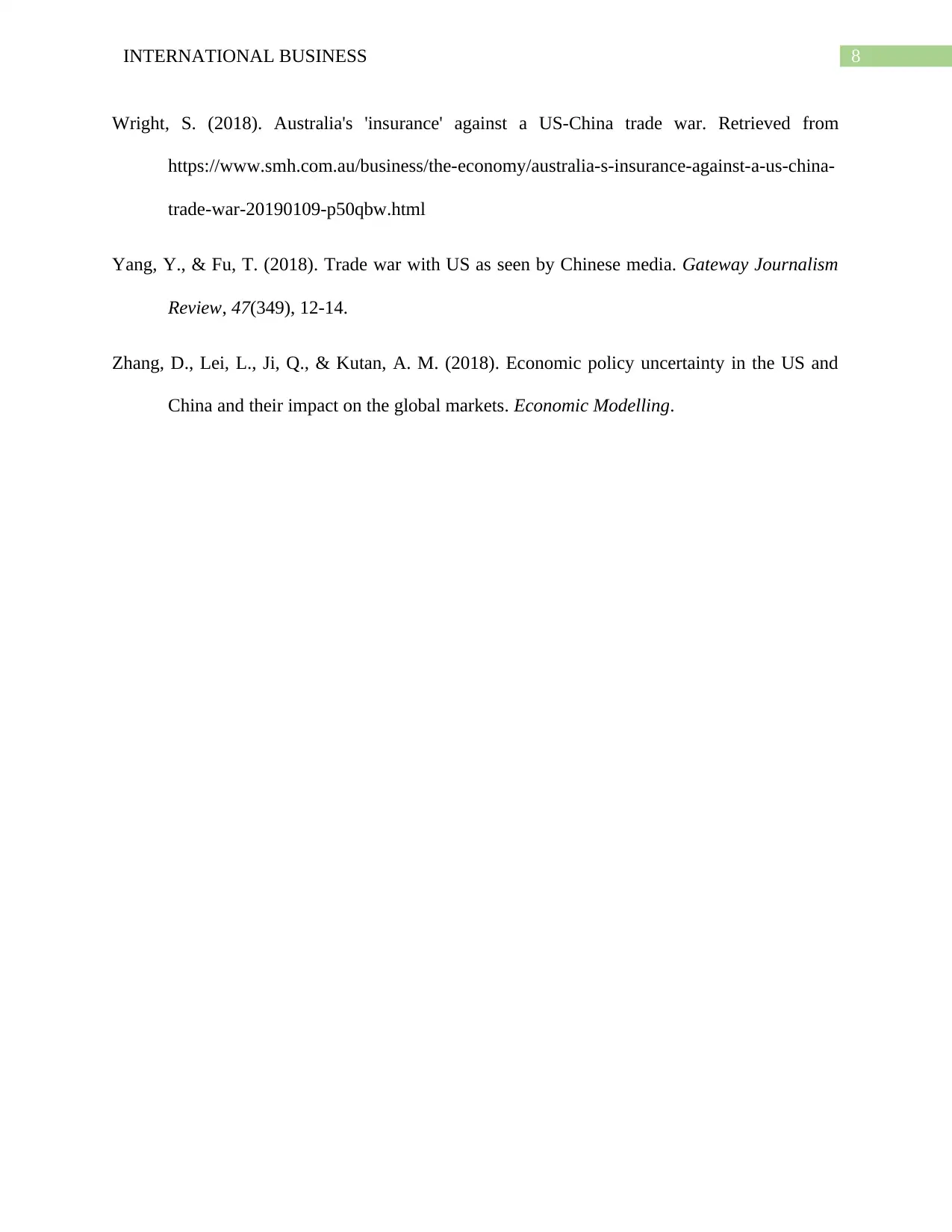
8INTERNATIONAL BUSINESS
Wright, S. (2018). Australia's 'insurance' against a US-China trade war. Retrieved from
https://www.smh.com.au/business/the-economy/australia-s-insurance-against-a-us-china-
trade-war-20190109-p50qbw.html
Yang, Y., & Fu, T. (2018). Trade war with US as seen by Chinese media. Gateway Journalism
Review, 47(349), 12-14.
Zhang, D., Lei, L., Ji, Q., & Kutan, A. M. (2018). Economic policy uncertainty in the US and
China and their impact on the global markets. Economic Modelling.
Wright, S. (2018). Australia's 'insurance' against a US-China trade war. Retrieved from
https://www.smh.com.au/business/the-economy/australia-s-insurance-against-a-us-china-
trade-war-20190109-p50qbw.html
Yang, Y., & Fu, T. (2018). Trade war with US as seen by Chinese media. Gateway Journalism
Review, 47(349), 12-14.
Zhang, D., Lei, L., Ji, Q., & Kutan, A. M. (2018). Economic policy uncertainty in the US and
China and their impact on the global markets. Economic Modelling.
⊘ This is a preview!⊘
Do you want full access?
Subscribe today to unlock all pages.

Trusted by 1+ million students worldwide
1 out of 9
Related Documents
Your All-in-One AI-Powered Toolkit for Academic Success.
+13062052269
info@desklib.com
Available 24*7 on WhatsApp / Email
![[object Object]](/_next/static/media/star-bottom.7253800d.svg)
Unlock your academic potential
Copyright © 2020–2025 A2Z Services. All Rights Reserved. Developed and managed by ZUCOL.





